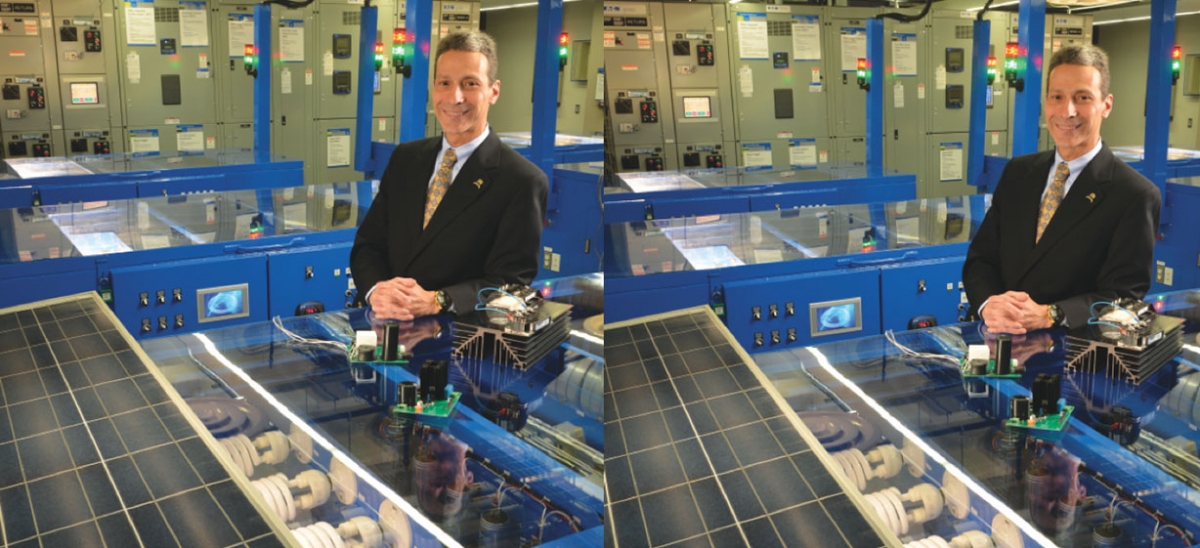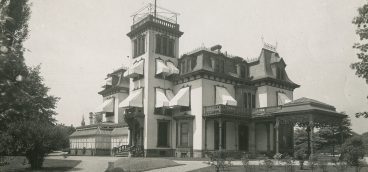
Three University of Pittsburgh professors have seen the future in electrical innovation, and it begins in Homewood. They’re talking about an electrical revolution, and it’s fitting that Pittsburgh and one of its poorest neighborhoods could play a large role.
In the late 1880s, Pittsburgh’s most famous Homewood resident, George Westinghouse, prevailed in what has since been labeled the “War of the Currents” to base the electric power grid of the United States on alternating current (AC). In New Jersey, Thomas Edison, “The Wizard of Menlo Park,” pushed for direct current (DC) and tried to label AC as dangerous. Edison, however, lost the argument because an AC electrical grid—back then—was less expensive, more efficient for long distance transmission, and much easier to construct.
Fast forward to 2015 and the University of Pittsburgh is positioned to become a national, and possibly international, leader in the study and implementation of direct current. The reason? A group of experts contend it’s less expensive, more efficient (and green), and could become easier to construct.
Alternating current continuously alternates the polarity of electricity several times a second—the positive wire becomes negative and the negative wire becomes positive. With direct current, the polarity of the wires remains constant. For example, batteries generate DC power, with the positive terminal always positive and the negative terminal always negative. Sources such as solar panels also can generate DC power.
Westinghouse’s preference for AC won over Edison’s DC for a variety of reasons. The technology had not developed to allow the high-voltage DC currents to be controlled safely over long distances. The longer the transmission requirement, the larger the DC cable needed to be and the higher the currents built up over the distance it had to travel. So in order to deliver power safely using DC, Edison’s concept required a power plant every several miles to generate electricity. AC didn’t face that problem.
Also, electricity had to be transformed to extremely high voltages. The higher the voltage, the less electricity was lost in transmission, for instance from a power plant to a city many miles away. AC could be transformed to high voltages with relative ease. But DC couldn’t—until the past few decades with the invention of power transistors, which could be applied for power system applications. And there were other technical reasons favoring AC, such as the difficulty of building high-voltage circuit breakers for DC.
Ultimately in the late 1800s, Edison’s system was fine for a few homes or businesses in a small geographic area, but not for long-distance transmission to larger end-use requirements. Today, however, because of power electronics conversion technologies that implement high capacity transistors and other associated developments, DC can be transmitted over long distances more efficiently than AC, and countries in Asia and Europe already are investing in ultra-high-voltage DC transmission. While there is some limited application of high voltage DC in North America, our power grid infrastructure has seen little expansion since the 1970s, but today is in need of modernization and upgrades.
Pitt’s Gregory Reed, John Camillus and Bopaya Bidanda recently received an $800,000 grant from the Henry L. Hillman Foundation for “Leveraging DC Power and the Business of Humanity to Transform the Pittsburgh Region.” They are convinced that DC will become a more efficient and affordable way to deliver energy.
Reed, professor of electrical and computer engineering and director of Pitt’s Center for Energy in the university’s Swanson School of Engineering, has been working with DC power for well over a decade. He plans to use his portion of the grant to further develop the technology for wide-scale application. In particular, Reed is working with students and colleagues in a new power systems laboratory to research both high-voltage DC transmission systems and low-voltage DC micrograms.
Camillus and Bidanda will use DC to advance their Business of Humanity® Project, which looks to combine economic growth and social benefit. They started the project several years ago, funded by a variety of university, government and foundation grants. With the Hillman funds, they plan to retrofit three row houses and a community center in Homewood to run on DC power. Additionally, they anticipate opening a commercial greenhouse in Homewood that uses DC power generated from solar panels. Camillus and Bidanda are partnering with John M. Wallace Jr., a pastor and professor of social work at Pitt, whose church owns some of the Homewood property.
“This is a total win for Homewood,” said Camillus, a professor of strategic management at Pitt’s Katz Graduate School of Business. “We see this as a prototyping opportunity.”
Reed and Camillus argue that DC is now a better option for several reasons. AC is usually generated by large, distantly located power plants that are major polluters, while DC can be generated by local, renewable green sources such as solar panels and other distributed energy resources.
Nearly all modern electronic equipment (computers, cell phones, TVs, etc.) require DC power, and if the power supplied to homes and offices were DC, that would eliminate the estimated 11-15 percent energy loss currently incurred in the conversion from AC to DC inside the home or office. Also, DC lighting (LEDs) and the latest design of DC motors are much more energy efficient than AC lighting (incandescent) and AC motors.
Bidanda, chairman of the Swanson School’s department of industrial engineering, said the popularity of DC power is likely to grow in residential households and businesses in the next 10 years, pointing to India and China where DC power is in use in rural areas where electric grids are not available. Bidanda and Camillus are working with partners in India to gain insight into the Homewood initiative.
“I’m looking more at the larger picture,” Bidanda said. “I am hoping to use the Homewood project as a showpiece to really transform Western Pennsylvania. We’re trying to put together another renaissance in Pittsburgh. Our overall vision is to make the region the center for DC power manufacturing and research of components of DC power.”
Reed is studying the option of converting the longstanding AC power grid to a DC grid. “The reason DC became a better means of transmitting long distances was really the advent of the transistor in the 1970s,” he said. “But the AC infrastructure was already in place. We are in the midst of an evolution of modernizing the power grid infrastructure, and DC has become a viable option based on the capabilities of power electronics technologies. But this will be a long-term endeavor and much development needs to occur. You couldn’t go to a builder today and say, ‘Build me a DC home.’ There are no standards or practices yet in place for that, as just one example of the challenges to overcome.”
Camillus piqued Professor Wallace’s curiosity in October 2013 by inviting Wallace to participate in an international conference in Prague in 2013, organized by the Business of Humanity® Project, entitled “Energizing Low-Income Communities: The Promise of DC Technology.” The conference drew 80 people from three continents, including Pittsburgh Mayor Bill Peduto and Grant Oliphant, then president and CEO of The Pittsburgh Foundation and current president of the Heinz Endowments.
“Much of the conversation was about exploring innovative ways to reduce costs in low-income communities,” said Wallace, senior pastor of the Bible Center Church in Homewood. “Oftentimes, when new housing is built, we don’t take the costs of utilities into consideration. We talked about finding a model or template to test out the viability of direct current in low income areas, such as Homewood.”
Wallace’s church owns property that will be developed to operate on DC power. And by the end of this year, Camillus said, the grant money will help fund a new commercial greenhouse in Homewood in which electrical equipment—lighting, pumps and ventilation—will run on DC power. Food will be grown at the greenhouse and distributed throughout the neighborhood, which currently does not have a grocery store.
After the greenhouse is up and running, Camillus, Bidanda and Wallace plan to modify three row houses and a community center in Homewood to run on DC power. Design, construction and manufacturing jobs along with greenhouse staff employees are another of the project’s expected benefits.
“We hope to make an impact great enough that other companies and regions replicate what we develop in Homewood,” Camillus said. “This can be transformative. We plan to make Pittsburgh the focal point for DC power. DC is green, more efficient and good for the environment. And the shift to DC will be a source of new jobs.”
The professors envision eventually installing a microgrid—a self-sufficient, geographically contained DC energy system with solar panels and small wind turbines—at a new housing development or a university campus.
Reed eventually plans to administer his studies in a commercial or industrial setting. The core of his research has centered on developing DC power technology that works throughout the entire chain of electricity distribution. In the near future, he will be working with regional corporate and community partners to further test and deploy the technology.
“We’re not going to go out and replace millions of miles of AC cable and infrastructure that exists today,” Reed said. “We want to continue looking at ways to integrate DC first, creating new infrastructure that we can build upon, and also integrating the development of hybrid AC/DC systems.”
Wallace has learned a great deal about DC quickly. “This is very fascinating stuff,” he said. “And it’s a great opportunity to ascertain the viability of being able to spread this new model in the region and hopefully beyond.”





